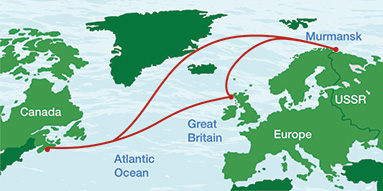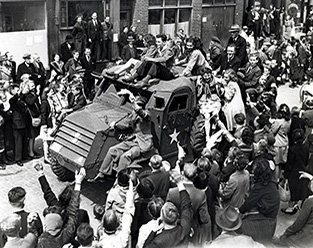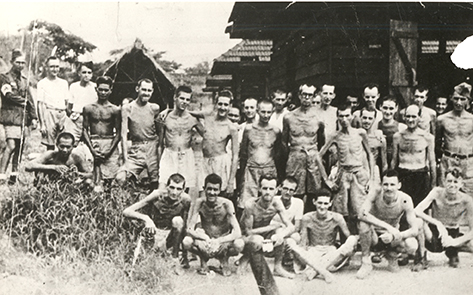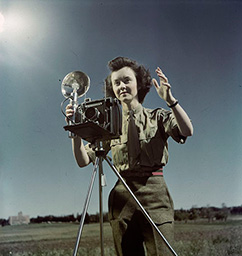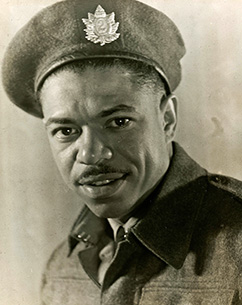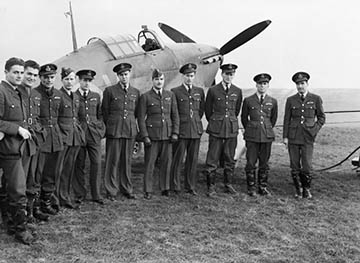Canada Remembers Times - 2015 Edition - Page 2
A Deadly Passage
Approximate route of convoys from Halifax to Murmansk.
One of the most dangerous routes sailed by the Merchant Navy during the Second World War was the notorious Murmansk Run. Despite constant German attack and extreme weather conditions, supplies were shipped to the Arctic port of Murmansk to assist the Soviet Union in its fight against Germany. It was so dangerous that if a ship was sunk, other vessels were not allowed to stop to help the survivors because they too could have become an easy target for attack.
From 1941 to 1945, more than 40 convoys sailed, transporting millions of tons of supplies, such as aircraft, tanks, jeeps, locomotives, flatcars, guns, ammunition, food, fuel and millions of pairs of boots. This support helped the Soviet Union to continue fighting Germany on the Eastern Front, thus preventing the Germans from concentrating all their forces against the Allies in the West.
The Liberation of the Netherlands
Canadians being welcomed in Rotterdam in May 1945.
(Photo: Library and Archives Canada PA-116668)
This year marks the 70th anniversary of the Liberation of the Netherlands during the Second World War. In late 1944 and early 1945, the Canadians battled to push the Germans from the country they had occupied since the spring of 1940. With its challenging terrain of canals, dikes and floodlands, the Netherlands was a tough place to fight.
After opening battles in the fall of 1944, including the bitter Battle of the Scheldt, bad weather brought the Allied offensives there to a halt. That winter was a terrible time for the Dutch—food and fuel supply reserves were gone; people ate tulip bulbs and scavenged through garbage to survive. Thousands starved or froze to death.
Early in the new year, the push began anew to liberate the entire country and finally end the war in Europe. The Canadian troops were cheered as one town after another was freed. It was a memorable period, as one Dutch teenager at the time recalled:
“As the (Canadian) tank came nearer […] there was a big hush over all the people and it was suddenly broken by a big scream, as if it was out of the earth. And the people climbed on the tank […] and they were crying. And we were running with the tanks and the jeeps all the way into the city.”
Helping liberate the Netherlands was a proud achievement for our country and one which the Dutch people still remember today with great gratitude. Sadly more than 7,600 Canadians died in the effort.
Victory at Long Last
Canadians in a Japanese prisoner of war camp.
(Photo: Veterans Affairs Canada)
During the Second World War, approximately 10,000 Canadians served in Asia. Almost 2,000 soldiers from Manitoba’s Winnipeg Grenadiers and Quebec’s Royal Rifles of Canada set sail for Hong Kong, in late October 1941, to help defend the British Crown Colony.
The Japanese invaded on December 8, 1941. Badly outnumbered, the defenders fought bravely before being forced to surrender on Christmas Day. Approximately 290 Canadians were killed and almost 500 wounded. The survivors’ ordeal was just beginning. Over the next four years, more than 260 would also die as a result of malnutrition, beatings by prison camp guards and forced labour. Ronald Routledge of Saskatchewan was there:
“Well, I went down to a hundred pounds, you know. I was maybe a hundred and eighty odd pounds when I was my normal weight, but I was down to about a hundred pounds.”
Many other Canadians also saw action in Asia during the war, including thousands of Royal Canadian Air Force airmen who served in the Burma Campaign as radar operators and members of bomber, transport, reconnaissance and fighter squadrons.
Squadron Leader Leonard Birchall of Ontario was even dubbed “the Saviour of Ceylon” by British Prime Minister Winston Churchill after his plane spotted a Japanese invasion fleet in the Indian Ocean that was heading for the island of Ceylon (now known as Sri Lanka).
Japan surrendered on August 15, 1945, after atomic bombs were dropped on Hiroshima and Nagasaki.
V-J (Victory over Japan) Day marked the end of years of fighting in the Second World War. The Canadian prisoners of war were finally liberated and returned home.
Hooray for Hermie!
Sergeant Karen Hermiston with her Speed Graphic Camera.
(Photo: Library and Archives Canada R112-1842-0-E)
The Canadian Army Film and Photo Unit was established in 1941 to record our country’s involvement in the Second World War.
The unit was made up of people familiar with photography and filmmaking. They were a unique bunch, with backgrounds ranging from movie directors to Hollywood stuntmen! Standing out in this group, however, was one female photographer. Against great odds, she eventually found a place in a field traditionally filled by men. Her name was Sergeant Karen Hermiston, and she was the first (and only) female photographer in the Canadian Army during the war.
“Hermie,” as she was known, spent more than four years in uniform snapping pictures of her fellow Canadian Women’s Army Corps members. During that time she also gradually took on additional assignments like those done by the male photographers.
Whatever it would take to find the right angle, this trailblazer’s shots were picture perfect.
A Living History Lesson
Lester Brown in uniform in 1944.
(Photo: The Memory Project, Historica Canada)
Lester Brown was a Canadian Second World War soldier who came ashore at Juno Beach on D-Day on June 6, 1944, and fought in the Battle of Normandy.
Twenty-three-year-old Private Brown of the Queen’s Own Rifles and his platoon were fighting in a village in France called Bretteville-sur-Laize when they were ambushed by the Germans. To escape the hail of fire, Brown and a fellow soldier ran for the cover of a nearby tank but, sadly, his comrade was killed at his side.
Brown was wounded in the face and knee, however there would also be invisible scars from what he had experienced. He survived the war, married and raised a family, but would long be haunted by nightmares about that horrific day before passing away at the age of 92.
Listening to the stories of Veterans who were there can help us begin to understand the hardships that happen in war. Search online for the Memory Project or explore the Heroes Remember collection to hear more touching first-person wartime accounts.
A Showdown in the Skies
Royal Canadian Air Force pilots in the United Kingdom in October 1940.
(Photo: Public domain)
The Battle of Britain raged 75 years ago in the late summer and fall of 1940. The German air force attacked the United Kingdom in an effort to gain control of the skies and pave the way for an invasion during the Second World War.
Against great odds, the outnumbered Allied airmen—including hundreds of Canadians—successfully defended the island nation and beat back the determined enemy.
It was a crucial turning point that would allow the Allies to maintain a foothold in Western Europe and eventually return to the occupied continent and help liberate its people in 1944 and 1945.
In the words of British Prime Minister Winston Churchill about these brave heroes of the sky,
“Never was so much owed by so many to so few.”
- Date modified:
